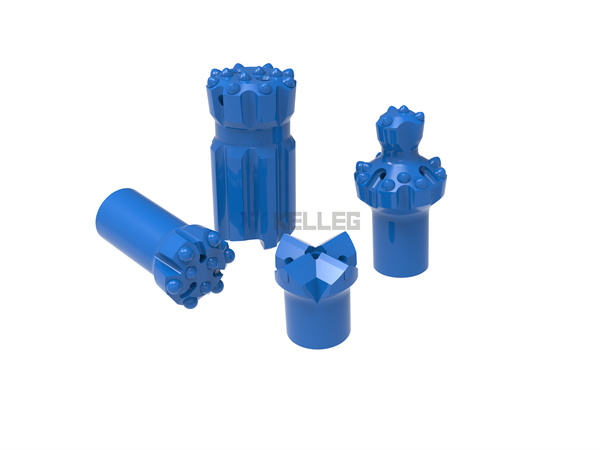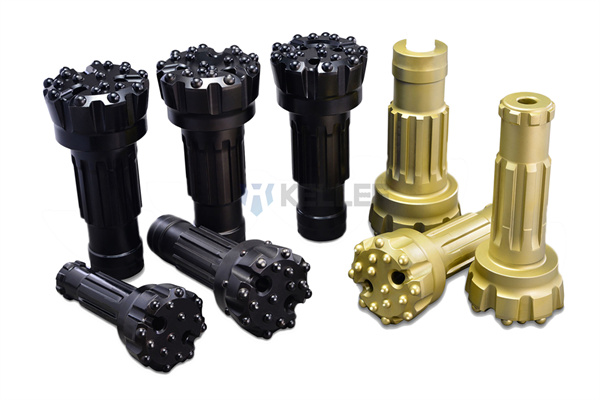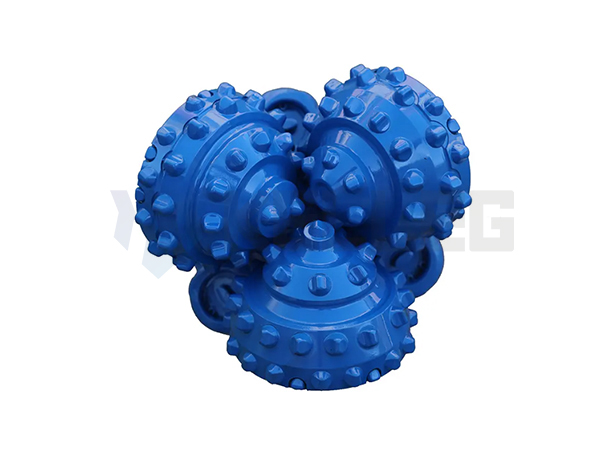2020 官网升级中!现在您访问官网的浏览器设备分辨率宽度低于1280px请使用高分辨率宽度访问。
Drilling rock is essential in construction engineering, geological exploration, and mining. Selecting the appropriate drill bit influences work efficiency, as well as the cost and safety of the operation. We will introduce the types of drill bits suitable for rock drilling and explain their characteristics and application scenarios.
Top hammer rock drill bit

The top hammer rock drill bit is a tool component. The drill bit body is made of high-quality steel, with carbide buttons produced through specialized processing and welding techniques. These bits are widely used in various mining projects. The classifications include chisel bits, cross bits, three-edge drill bits, and button bits.
1. The chisel bit is suitable for light rock drills to drill rock formations with low hardness, which is easy to grind.
2. The cross-bit and X-bit are suitable for drilling fractured rock formations and abrasive rock formations under the conditions of rock drills with high impact power and have strong resistance to radial abrasion.
3. The button bit is more suitable than the sheet insert drill bit for rock drills with high-impact power. It offers higher rock drilling speed, longer service life, and produces rounder hole types.
DTH drill bit

The DTH drill bit is a kind of drill tool connecting the impactor with the spline of the drill bit to guide and transmit the rotation for the impact, with the drill bit and the DTH hammer diving into the hole to break the rock. DTH drill bits include high, medium, and low wind pressure DTH drill bits. There are mainly four types of end-face designs: convex type, flat type, concave type, and deep concave center type.
1. Convex type: It can maintain a high rock drilling rate when drilling medium-hard and hard abrasive rocks, but the straightness of the drilled hole is poor, which is not suitable for rock drilling projects with high requirements for blast hole straightness.
2. Flat type: It is relatively strong and durable, suitable for drilling hard and ultra-hard rocks, and suitable for drilling medium-hard rocks and soft rocks with low requirements for blast hole straightness.
3. Concave type: There is a conical concave part on the end face, which is a slight nucleation effect formed by the drill bit during the rock drilling process to maintain the centering performance of the drill bit. The drilled blast hole has good straightness. This drill bit has a good powder removal effect and fast drilling speed.
4. Deep concave center type: It is used for nucleation during rock drilling and ensures the straightness of the blast hole when drilling deep holes. It is only suitable for drilling soft rock and medium hard rock.
Rotary drill bits

When the rotary drill bit is working, the cutting teeth contact the bottom of the well alternately, the rock-breaking torque is small, the contact area between the cutting teeth and the bottom of the well is small, the specific pressure is high, and it is easy to eat into the formation; the total length of the working edge is long, so the wear is relatively reduced. Rotary drill bits can adapt to a wide range of formations, from soft to hard. According to the number of cones, there are single, double, triple, and multi-cone bits. The roller cone bit is the most widely used and common type domestically and internationally. Rotary drill bits are an essential and crucial component in the oil, earth, and various drilling industries.
PDC drill bit
PDC drill bit is a drill bit with a circular composite piece welded on a cylindrical cutting tool, and the cutting tool is mounted on the drill bit body. It includes PDC drill bits for geological exploration, PDC drill bits for coalfield drilling, and PDC drill bits for oil exploration.
PDC drill bits for geological exploration: composite drill bits are primarily used for geological exploration and are suitable for soft to medium-hard rock formations. Recently, some manufacturers have developed new composite pieces that can be applied to rock formations with a hardness of up to ten levels.
PDC drill bits for coalfield drilling: mainly used for drilling and mining coal seams in coal mines. Generally speaking, the rock formations in coalfields are relatively soft, and composite drill bits are widely used, such as anchor drill bits and three-wing drill bits.
PDC drill bits for oil exploration: mainly used in drilling and using drill bits in oil and gas fields. Currently, composite drill bits for oilfields are the most expensive and demanding of all composite drill bits. It can be said to be the aristocrat among composite drill bits.
Importance of choosing the right drill bit
Choosing the right drill bit can significantly impact the efficiency and cost of drilling rock. Here are a few key factors to consider when selecting a drill bit:
Rock hardness: the hardness of the rock is the first factor to consider when choosing a drill bit. Rocks of different hardness require drill bits of various materials to deal with.
Drilling depth: the drilling depth determines the pressure and wear the drill bit must withstand. For deep hole drilling, it is crucial to select a drill bit with higher wear resistance and strength.
Drilling speed: drilling speed is one of the critical indicators to measure the performance of a drill bit. Choosing the right drill bit can increase the drilling speed, improving work efficiency.
Cost-effectiveness: when choosing a drill bit, we should consider cost-effectiveness. Although high-performance drill bits can improve drilling efficiency and reduce wear rate, the cost is also relatively high. Therefore, it is necessary to weigh the actual situation when choosing a drill bit.
Conclusion
Choosing the right drill bit has a vital impact on the efficiency and cost of drilling rocks. When selecting a drill bit, we should consider factors such as rock hardness, drilling depth, drilling speed, and cost-effectiveness. At the same time, regular maintenance and maintenance of the drill bit is also the key to extending its service life and improving drilling efficiency.